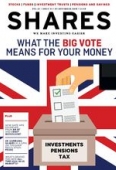Archived article
Please note that tax, investment, pension and ISA rules can change and the information and any views contained in this article may now be inaccurate.
Investment trust underperformers named and shamed

Investment trust investors put money to work with an active fund. So if the fund fails to beat the market or its assigned benchmark, you’ll understandably feel aggrieved.
The aim of active management is to outperform a benchmark and if the manager to which you entrust your hard earned savings fails to beat the market, then why not just invest in a low-cost passive fund?
As a way of trying to spot the laggards, we’ve identified 26 investment trusts that have sat in the bottom quartile of their respective sectors on a one, three and five year basis, based on performance data from FE Fundinfo.
We would normally expect consistent underperformers to either have a new manager to drive change or be wound up. This is happening in some situations but it is surprising to see many investment trusts continue to limp along without any intervention from the board of directors or shareholders.
The accompanying table shows all 26 names and we explain what’s going on with several of them later in the article.
TAKE A CLOSER LOOK
Don’t automatically write them all off as being bad investments because certain styles may have been out of favour. The data looks at groups of trusts and so one with a value approach, for example, may have been lumped in with one chasing growth opportunities. The two funds might sit together because they both live in the same sector such as the ‘global’ category where they invest in companies around the world. Growth has been in fashion and value has been out of fashion for quite some time.
EXAMPLES OF UNDERPERFORMERS
Sometimes market events make it hard to thrive if an investment trust has a specific focus rather than a broad mandate. Ground Rents Income’s (GRIO) de-rating reflects uncertainty surrounding Government leasehold reform. Trading on a 16% discount to net asset value (NAV), the fund has implemented a strategic review and switched fund manager from Brooks Macdonald to Schroders in a bid to reverse its flagging fortunes.
Joining it in the investment trust performance doghouse is global energy investor Riverstone Energy (RSE). A whopping 57.3% discount to NAV reflects half a decade of underperformance amid a spell which included a large decline in the oil price.
Third quarter results (30 Oct) were impacted by a renewed fall in oil prices which acted as a catalyst for further compression in the multiples of exploration and production (E&P) names. Jefferies analyst Matthew Hose says tackling the discount ‘should be key’ for the Riverstone Energy board, while rather ominously, a discontinuation vote next year is ‘seemingly inevitable’ according to Hose.
LONG-TIME LAGGARD
A dire half-decade-long performer, according to the FE Fundinfo data, British & American (BAF) has delivered negative share price total returns over one, three, five and 10 year periods, lagging its benchmark FTSE All-Share index in the process.
Some of the pain has come from its main US investment, biopharmaceutical business Geron, whose shares cratered after Johnson & Johnson unexpectedly withdrew from their partnership in September 2018.
Subsequent positive developments from Geron have driven something of a share price upswing in 2019, although Geron needs to perform for the trust’s performance to pick up.
British & American is keeping the faith, insistent that Geron ‘continues to represent a strong and compelling investment opportunity’ and remains ‘the focus of our efforts to realise capital gain in the portfolio given the current outlook for the wider investment markets’.
IS THIS A WIND UP?
When wading through the data, investors should be on the lookout for below-par performance, while keeping an eye out for portfolios that are simply being wound up, with proceeds returned to shareholders.
For instance, among the underperformers is Ashmore Global Opportunities (AGOL). In early February 2013, its shareholders actually voted to wind up the company and that process is still ongoing.
Another example is AXA Property Trust (APT) which is trading at a 31.3% discount to net asset value. The FE Fundinfo data says the trust has underperformed over one, three, five and 10-year time frames. However, AXA Property is a misnomer. Shareholders have already voted for an investment policy change and almost all of its real estate assets have been sold with the proceeds distributed to shareholders.
This trust has morphed into a deep value investor, taking stakes in UK small caps trading at a deep discount to their intrinsic value, under the guidance of new investment advisor Worsley.
Important information:
These articles are provided by Shares magazine which is published by AJ Bell Media, a part of AJ Bell. Shares is not written by AJ Bell.
Shares is provided for your general information and use and is not a personal recommendation to invest. It is not intended to be relied upon by you in making or not making any investment decisions. The investments referred to in these articles will not be suitable for all investors. If in doubt please seek appropriate independent financial advice.
Investors acting on the information in these articles do so at their own risk and AJ Bell Media and its staff do not accept liability for losses suffered by investors as a result of their investment decisions.

 magazine
magazine











